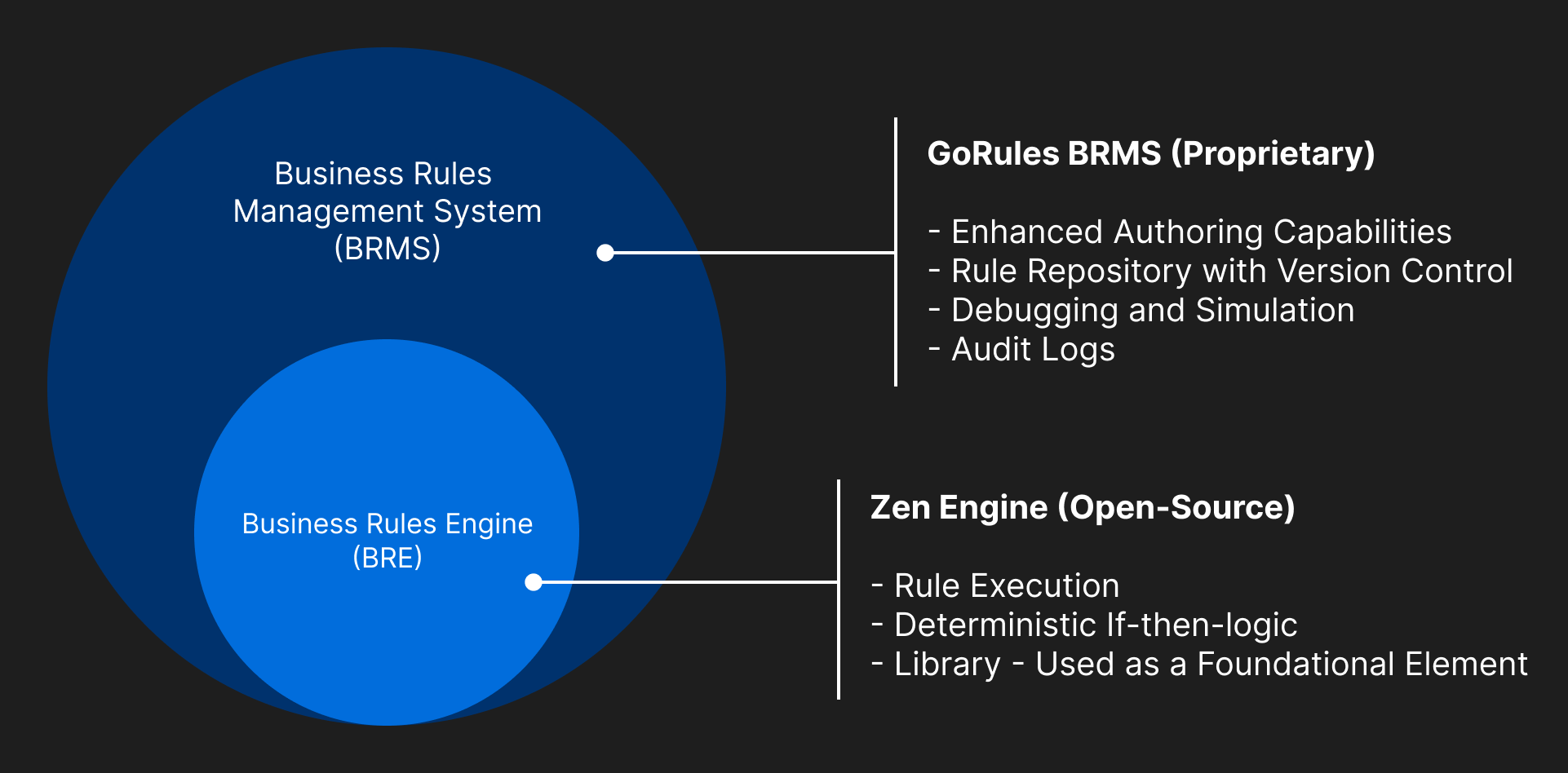Business Rules Engine (BRE) vs
Business Rules Management System (BRMS)
At the high level, ZEN Engine (BRE) and GoRules BRMS serve distinct yet complementary roles in the realm of business operations. The ZEN Engine, as an open-source and embeddable Business Rules Engine, focuses on flexibility and integration, allowing businesses to customize and seamlessly incorporate rule processing into their existing systems. On the other hand, GoRules BRMS offers a centralized approach to business rules management and execution, emphasizing unified governance, collaborative development, and analytical insights to streamline and enhance decision-making processes across larger organizations.

ZEN Engine: Business Rules Engine
A ZEN Engine is a software library that integrates directly into code and can execute business rules in a runtime environment. The primary function of a Engine is to decouple business logic from the code and allow external management without the need to redeploy the code.
Key Features of ZEN Engine:
- Embeddable: BRE can be integrated into larger systems, acting as a component in a more complex ecosystem.
- Cross-platform: With Core built in Rust we are aiming to provide light weight native wrappers across all main programming languages.
- Open-source: ZEN Engine is Open-source and can be found on the GitHub.
- Intuitive UI Editors: Two Open-source Editors available: React Component - JDM-Editor and Standalone Editor.
When to use?
If you're developing a product or solution that requires robust, efficient rules management without the overhead of a full BRMS, ZEN Engine delivers exactly what you need.
UI Editors produce JDM files that can be interpreted by ZEN Engine, but it is up to you to manage how these JSON files are stored and loaded into the engine.
GoRules BRMS: Centralised Rules Repository
On the other side, GoRules BRMS is an all-encompassing Business Rules Management System. It extends beyond the capabilities of a ZEN Engine, offering a complete repository and environment for the lifecycle management of business rules.
Key Features of BRMS:
- Repository: BRMS offers a DB repository for storing and managing business rules.
- User-Friendly Interface: It provides a user-friendly interface for non-technical users to create, modify, organise and test the rules.
- Built-in Engine: It has built in Rules Engine (ZEN Engine) and allows other services to integrate over API.
- Version Control: BRMS includes version control, which helps in tracking changes and maintaining different versions of rules.
- Releases and Lifecycle: BRMS can manage releases and promotion of the decision models between environments.
- User Management: It has built in user management with optional Azure AD or Okta integration.
- Docker: Easy deployable into any docker system such as Kubernetes, Azure ContainerApps, AWS ECS and others.
When to use?
GoRules BRMS is the optimal choice when your organization requires centralization, comprehensive management, and governance of business rules across various departments and systems. It's especially suitable for scenarios where non-technical stakeholders need to directly create, modify, and oversee rules, ensuring that business logic aligns seamlessly with evolving organizational strategies and regulations.
Key Differences between BRE and BRMS
While a BRE is solely focused on the execution of business rules, a BRMS provides a more holistic approach to managing these rules. Here are some key differences:
- Scope: BRE is a subset of BRMS. While BRE just deals with the execution, BRMS also handles the lifecycle management of business rules.
- User Accessibility: BRMS is generally more accessible to business users, allowing them to create and modify rules without deep technical knowledge.
- Embeddable vs. Standalone: BRE is often a component of a larger system, whereas BRMS can be a standalone system providing end-to-end solutions.
- Integration and Evaluation: BRE integrates directly in the code while BRMS integrates over API.
- Complexity and Features: BRMS is more complex and feature-rich compared to BRE, offering additional functionalities like rule governance, release management and others.